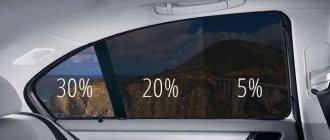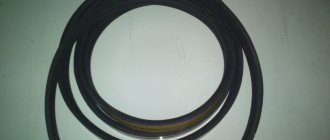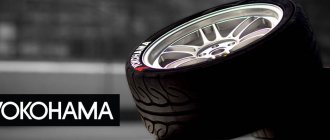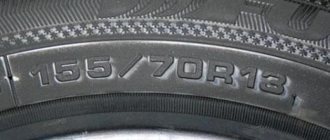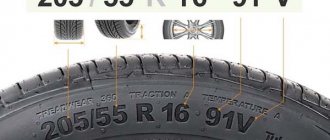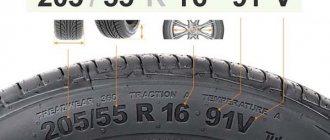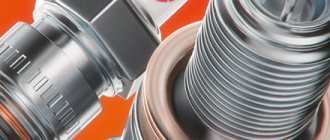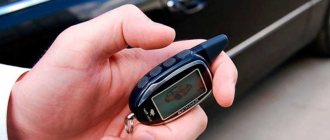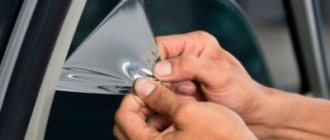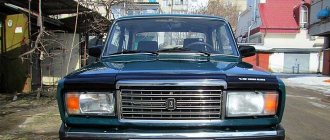The markings on the car glass are purely informative, but they can be used in two situations - when replacing broken glass and when buying a used car. We will tell you in detail what the secret is and how to use it for personal needs.
Firstly, if you look in more detail when buying a car, you can determine whether they were replaced or not. Because on any glass, in the corner, there is a standard marking indicating the type, year of manufacture and manufacturer. And secondly, you can also see what manipulations the thieves tried to carry out after the car was stolen, if the so-called anti-theft marking was additionally applied (vin code engraved). Thus, it is able to protect or warn the car owner.
Interactive image of the marking symbol. Works on mouseover
Briefly, the most basic information about auto glass is discussed in the picture. And in order to understand in more detail the designation of markings on glass applied by the manufacturer, first let’s find out what types of materials there are and standards for presenting information.
Types of materials
Today there are 3 types of materials, 5 types of markings for auto glass and about two dozen manufacturers, we will deal with them further. But first of all, let’s look at what the glass markings should contain:
- glass type;
- trademark or manufacturer's name;
- approval marking in accordance with UNECE Regulation R43 or Directive 92/22/EEC of the European Economic Community;
- auto glass production date.
Let's divide manufacturers into 3 groups:
- Premium class - Pilkington, Saint Gobain Securit, AGC, PPG.
- Business class – JAAN, Guardian, Shatterprufe.
- Economy class - XYG, CSG, FYG, Starglass, Tamglass, and other manufacturers.
Now let's look at the types of materials used for the manufacture of automobile glass and decipher where this is indicated:
- Triplex (from Latin Triplex - triple). This is glass, which consists of many layers, most often three, glued together with a transparent polymer film when heated under pressure. It is mainly used to make windshields, sometimes side, rear or even hatches. As a rule, such glasses are designated by the word Laminated, Lamisafe - laminated glass.
Advantages of Automotive Glass
with “triplex” type:
- high strength against impacts;
- after a strong impact, only a crack may appear on the glass, which will not spread over the entire surface of the glass;
- even if the windshield is cracked due to a stone or other object hitting it, it will not break; with the help of a polymer film, the fragments will be held in place and will not scatter throughout the cabin, which is a characteristic advantage for passengers who are in the car;
- the glass is so strong that an attacker still needs to try harder to get into the cabin;
- absorbs noise quite well;
- reduces thermal conductivity and thermal stability, as well as the possibility of painting.
Automotive glass with a large number of layers is used quite rarely, and then, as a rule, in exclusive premium car models, as well as in armored cash-in-transit vehicles.
- Stalinite is ordinary glass, which is made by tempering . After the glass has been heated to a temperature of 350-680°C, upon contact with air, during cooling, a residual compressive stress is formed on its surface, which actually ensures high strength, heat resistance and safety in case of damage.
Rear and side windows are mainly made from this material. Markings, as a rule, on such glasses are indicated by the word Tempered, Temperlite, Therlite , which means tempered glass or simply the letter “ T ”.
Anti-theft marks
There is also anti-theft marking. Its presence is determined by the VIN number of the car - this is a special identification code that is also located on the body and engine. It is displayed in digital versions:
- The code is applied in the form of dots or the characters are written out completely.
- Only the last digits are indicated.
- It is etched onto the glass and it takes on a matte finish.
Special marks indicate car windows and mirrors. They are also written on the headlights and taillights of vehicles. For application, a special stencil etching method with a special paste containing acid is used. Sometimes they use sandblasting, spraying coarse quartz sand under pressure onto the glass. Anti-theft marking provides its advantages:
- If a car is stolen, then in order to sell it, the thief will try to erase the inscription of the year of manufacture so that he will not be identified. It is almost impossible to officially sell such a car.
- Marking allows you to quickly detect glass, headlights, and windshields that were stolen through dismantling points and service centers.
- The cost of anti-theft marking is low when compared with the damage caused by car theft.
Labeling Standards
Manufacturers of car glass typically use two types of markings:
The American type of marking must be made in accordance with the FMVSS 205 standard. All auto glass, such as OE, which is supplied to the conveyor of car factories, as well as spare parts, must be marked with appropriate information that confirms the safety of the product. There is a marking in the form of a monogram, which is known as “beetle”. Different manufacturers put different markings, but regardless of this they carry the same information.
43R-00346 - Compliance with the European safety standard ECE R43 (European Rejuvenation)
DOT-376 Manufacturer certification meets US Department of Transportation standards
European type of marking . Europe has safety standards that apply to auto glass installed on vehicles sold in its territory. Since they apply the laws of different countries, a single standard has been developed, adopted by all EU member countries. According to the standard, the letter E must be inside the monogram. Some automotive glass components sold and installed in the United States also contain AS and European markings.
And in Russia, as a rule, according to the GOST standard (5727-88), markings must be indicated by a digital-alphabetic code, which encrypts information about the type of product, type of glass, thickness of glass and film, grade of product and technical conditions for a specific product.
Replacing car glass
Replacing car windows yourself, what is needed for this and is it really possible to change the windshield yourself in 10 steps. How does the replacement procedure occur and what tools and materials are needed. More details
How to get rid of cracks in glass? DIY windshield repair
To repair a windshield yourself, you will need a photopolymer, an injector (plastic/metal) for applying it, and a drill, which can be used to prevent the crack from spreading. More details
Windshield polishing
We will tell you when you need to polish your windshield, what you need for this, how to do the procedure yourself, and also what not to do. More details
Markings on the windows of different cars
The markings on the windows of different cars have their own characteristics. It should be noted that the markings on domestic cars differ from those placed on foreign cars. Next we will look at their differences.
VAZ glass marking
In the distant past, all domestic cars were equipped with BOR glass, which was produced at a large Russian plant. This designation testified to the quality, affordable price and originality of the product. At the moment, BOR is part of the AGC group of companies. Next, we will look in more detail at the labeling of auto glass from the BOR company.
Explanation of BOR glass markings:
VAZ 2107 windshield markings
Marking on the design features of glass
In addition to basic information, data in the form of pictograms or inscriptions is also applied to the glass. They indicate the design features of automobile glass:
- If there is a picture in the shape of an ear or the inscription “Acoustic” is marked, then the glass has noise-absorbing properties. In other words, it is distinguished by increased noise absorption efficiency. As a rule, diesel car models are equipped with such glass.
- If it says Solar - glass with heat-reflecting properties. This option has a metal coating that is not noticeable to the naked eye. Due to this layer, about 40 percent of the heat energy is reflected and dissipated.
- Athermal or “chameleon glass” is marked with the inscription IR. This glass often gives off a purple tint, because PLV butyral and silver films are added between the layers. Thanks to this, up to 70 percent of heat energy is reflected and dissipated. It is clear that such glass will not be installed on regular versions of cars. They are the lot of top trim levels, and even then only of some German and French cars.
Decoding the markings on the glass
A logo or trademark tells you who the glass or car manufacturer is. It should be noted that it is not necessary to indicate one manufacturer’s logo; you can simply indicate a company that is a partner in glass production. Automotive glass markings are indicated in a special way and are placed in the right or left, lower or upper corner. In order to find out what the markings on the windshield mean, you need to read the information below.
The windshield markings are as follows:
The European marking code consists of three parts: the letter E and the country code inside the circle, the directive number and extension number, and the type of glass. The number inside the circle is the code of the country that approved the use of glass for installation on a car.
- Trademark, name of the plant, manufacturer. In our case, the glass is manufactured under the brands of Pilkington, a transnational concern, one of the largest manufacturers of auto glass in the world, and XYG, one of the largest manufacturers of auto glass in Asia.
- Designation of an extended type of automotive glass. are indicated by slanted Roman numerals, which mean:
- I – reinforced windshield;
- II – windscreen ordinary laminated glass;
- III – wind-treated laminated glass;
- IV – glass, which is made from plastic;
- V – other (non-window) glass with light transmittance below 70%;
- VI – double-layer glass with a light transmission coefficient below 70%.
- Country code (E) where the automotive glass was certified.
Decoding the glass manufacturer's country code Code A country Code A country Code A country E1 Germany E12 Austria E24 Ireland E2 France E13 Luxembourg E25 Croatia E3 Italy E14 Switzerland E26 Slovenia E4 Netherlands E16 Norway E27 Slovakia E5 Sweden E17 Finland E28 Belarus E6 Belgium E18 Denmark E29 Estonia E7 Hungary E19 Romania E31 Bosnia and Herzegovina E8 Czech E20 Poland E32 Latvia E9 Spain E21 Portugal E37 Türkiye E10 Serbia E22 Russia E42 European Community E11 England E23 Greece E43 Japan - M is a material number identifier, it indicates the properties of glass and contains the following information: glass thickness, color, coating, characteristics of fasteners and glass cement. The M code is not standardized; for example, Ford Motor Company uses the letters FM.
- Date of manufacture of automobile glass.
- The glass has passed light transmittance and penetration tests. ASI is a sign of compliance with the American standard, it means transparency, marked with numbers from 1 to 3, the most transparent auto glass is marked AS1.
AS - American National Standard for the Safety of Automotive Glazing Materials and Automotive Equipment Used on Highways.
- AS1 – placed anywhere on the car. This class of glass has been tested in accordance with ANSI Z26.1 for light transmittance and penetration. An exception is sun-protection windshields; their designations on car windows are placed in the upper corners of the windshield.
- AS2 - everywhere except the windshield. These glasses passed tests for light transmission, but not for penetration.
- AS3 is a value that is prohibited from being placed on a vehicle. The AS-3 designation applies only to dark glass. They are generally not tested for 70% light transmission or penetration. This type of glass is prohibited from being used as windshields and side windows on the driver's side, as they do not provide the required visibility.
Additional markings on windshields:
Laminated side windows provide safety
Laminated side windows: increased impact resistance
Publication date: September 19, 2022. Category: Automotive equipment.
The question of changing a vehicle sooner or later arises before any motorist. Of course, everyone wants to get into a new, comfortable car fresh from the showroom, but not everyone has such a financial opportunity. Therefore, the used car market is still very popular.
Buying a used car is always associated with numerous problems. Every seller tries to hide the details of the “life” of the car, especially if the vehicle has been in an accident. Of course, the deception can be quickly revealed with a full diagnosis, but such a procedure is not cheap, and it is most often paid for by the buyer. However, it is absolutely not necessary to spend money on such a procedure, since you can understand that the car has been in a serious accident by looking at its windows. If they break, they are guaranteed to be replaced. But it is impossible to restore the factory markings. Therefore, knowing the decoding of this data, you can easily identify deception.
Today there are a huge number of manufacturers who produce auto glass. However, only a few types of materials and types of markings are used in production. So let's start looking at it in order.
How to decipher glass markings?
If we talk at the everyday level, then paying attention to the markings on the windows will help when buying a used car. You can determine whether the windows have been replaced by previous owners and indirectly assess the likelihood that the car has been in a serious accident. It is clear that windshields change due to wear and tear and stones, but replacing all the glass on one side at once almost certainly indicates a serious accident in the past.
So, let's look at the markings using the windshield as an example:
Guardian - windshield manufacturer;
Laminated - laminated glass.
Interesting fact:
Laminated glass is often called “triplex” in our country, although this is just a Russified name that grew out of the Triplex trademark, just like a copier (Xerox) or a felt-tip pen (Flomaster).
Between the two layers of glass there is a layer of polyvinyl butyral film, due to which the glass does not crumble upon impact, but becomes covered with cracks and remains intact. In the event of a collision, laminated glass prevents solid objects from outside from entering the cabin and preventing unbelted passengers and objects from flying through the windshield.
II - regular laminated windshield (I - toughened windshield, III - specially treated windshield, IV - plastic glass);
DOT 22 - manufacturer certification to US Department of Transportation standards;
M50L1 - internal manufacturer code;
AS1 - compliance with the American standard, and therefore our GOST, in terms of light transmission - at least 75%. The side windows may have the value AS2;
43R - compliance with the European safety standard ECE R43;
E9 in a circle is the code of the country in which the glass was certified (but not manufactured!);
Country codes: 1-Germany, 2-France, 3-Italy, 4-Netherlands, 5-Sweden, 6-Belgium, 7-Hungary, 8-Czech Republic, 9-Spain, 10-Yugoslavia, 11-England, 12-Austria , 13-Luxembourg, 14-Switzerland, 16-Norway, 17-Finland, 18-Denmark, 19-Romania, 20-Poland, 21-Portugal, 22-Russia, 23-Greece, 24-Ireland, 25-Croatia, 26 -Slovenia, 27-Slovakia, 28-Belarus, 29-Estonia, 31-Bosnia and Herzegovina, 32-Latvia, 37-Turkey, 42-European Community, 43-Japan.
"TRANSP." - this is transparency, transparency, that is, light transmittance. 75% min. means that the glass transmits at least 75% of light
And finally, the most interesting thing is the decoding of the glass production date.
Unfortunately, there is no single standard for designating the month and year of glass production, and each manufacturer often comes up with its own encryption. Most display the months as dots and the year as a number. But on the glass shown in the illustration, the year was marked with asterisks. It was released in November 2012
Manufacturer
The most expensive products that are installed on Premium cars are manufactured by Pilkington (UK), Saint Gobain Sekurit (France), AGC (Japan) and Pittsburgh Plate Glass or PPG (USA). The most famous classes include JAAN (Poland), Guardian (USA) and Shatterprufe (South Africa). And finally, the “Economy” class is most often responsible for the companies XYG (China), China Southern Glass or abbreviated CSG (China), FYG (China), Starglass (Spain) and others.
Standards
There are two types of standards for the application of a specific glass. The American standard is designated by the symbols "DOT", "M" and "AS". The numbers after “DOT” indicate a certificate from the manufacturer (specific plant), which confirms that the product fully complies with the requirements of the US Department of Transportation. This means that using the “DOT” code it is possible to establish exactly in which country the glass was produced and by whom exactly. For example, the label below shows DOT473 and Pilkington. If we check the code “473”, we will see that the product really belongs to Guilin Pilkington, only it was made in China.
You can view all codes in the file below.
Go ahead. The symbol “M” and the numbers after it indicate the color and thickness of the glass.
One of the most important American standards is the light transmittance of the material (transparency). Depending on the numbers that come after “AS”, there are only three categories of automobile glass:
- AS1 – glass can be used as a windshield, side, etc. These are the highest quality products that meet all standards for light transmittance (at least 75%) and distortion. Therefore, they also comply with GOST of the Russian Federation.
- AS2 - glass of this type can be installed anywhere, but not as a windshield. Such products did not or could not pass the distortion test, but the light transmission functions are normal.
- AS3 – can only be used for rear side windows.
There is also a European quality standard, which can be easily identified by the letter “E” in a circle. Also next to it there may be a line that indicates “43R” and several numbers. This means that the product meets the ECE R43 European homologation standard. In order to clarify the specific country that issued the certificate, it is enough to remember the values of their table.
Healthy! There may be two codes on the glass at once, which are simultaneously responsible for compliance with American and European certificates. This means that the product has been certified (but not necessarily manufactured) in the EU for sale in the US or vice versa.
Also on the marking you can find the symbol “ССС” in a circle. This indicates that the glass was manufactured for the Chinese market and meets the quality standards of this country. If the glass was produced for European consumers, then in addition to this mark the symbol “E” will necessarily be present.
We continue to study the markings. If you look again at the picture from the example, you will notice that it also shows different labels - Lamisafe and Tempered. They will tell you what material the product was made from.
Materials used
Modern glass is used using two technologies, each of which has its own characteristics.
Laminated glass
Such products are most often called “triplex” and laminated glass, since they can have several layers (usually three), which are glued together with a special film during the heating process. Both windshields and side windows and hatches can be made from this material. On the marking the words Laminated or Lamisafe will tell us about the laminated glass.
Such products have many advantages. The main advantages of “triplexes”:
- They can withstand blows more steadfastly.
- Even if an impact occurs, such glass will not shatter. A crack will appear on it, but it will not “grow”.
- If a stone hits the windshield even at high speed, it will get stuck in the polymer film and will not reach the vehicle interior. Thus, “triplex” is much safer for the driver and passengers sitting in the car.
- This type of glass is so strong that an attacker who decides to break it and get into the interior will have to work hard.
- Thanks to its multi-layer nature, this material absorbs sounds much better. For the same reasons, “triplex” retains heat longer and is heat-resistant.
Strained glass
In this case, we are talking about a cheaper analogue, which is usually called “Stalinite”. It is a standard glass that has undergone a tempering process by heating at a temperature of up to 680 degrees. Due to the fact that after strong heating the material cools, a residual compressive stress is formed. Therefore, such glasses are considered safe and resistant to sudden temperature changes.
These are single-layer products that break upon impact. However, tempered glass does not break into large fragments, but into small granules with blunt edges. But this is also considered unsafe for people in the car, so most often such windows are used as side or rear windows.
On the label they are marked with the words Therlite, Tempered, Toughened, Temperlit or the letter “T”. Also on it you can often find several oblique Roman numerals, which are located on the left side, next to the name of the manufacturer and confirmation of certification.
What is automotive glazing?
With the development of technology, vehicle speeds have also increased, and, consequently, the requirements for the quality of visibility and the ability to see the space around the vehicle while driving have also increased significantly.
Automotive glass
Automotive glass is a body element that is designed to provide the required level of visibility and perform a protective function. The glass protects the driver and passengers from headwinds, dust and dirt, precipitation and stones flying off from under the wheels of other moving cars.
The main requirements for auto glass are:
- Safety.
- Strength.
- Reliability.
- Sufficient service life of the product.
Glass type
Oblique (can be even) sticks, as in the picture, will tell you about the features of the glass:
- I - indicates that the glass is compacted and made for use as a windshield;
- II – standard multilayer material (even if the glass does not indicate that it is “triplex”, you can be guided by this sign, since it indicates the material of manufacture);
- III – “triplex” treated with additional materials;
- IV – the product is made of plastic;
- V – glass cannot be installed as a windshield, since its light transmittance does not even reach 70%;
- VI is a two-layer material that is used for all windows except windshields.
Under all the described symbols there is information about the month and year of production of the car.
Types of automobile glass and their interpretation
Typically there are two types:
- Stalinite or Staling (the name of the manufacturing method) is manufactured at a temperature of 600 degrees Celsius and followed by rapid cooling. Such glass becomes strong precisely thanks to this heating-cooling process, but when broken it crumbles into many small pieces.
- Triplex - Essentially, this is multilayer glass, between the layers of which a special glue is poured that connects these layers; when such glass is hit, a crack usually forms and the glass does not spill out, even if it breaks through a hole in it, the glass will still retain its shape and will not collapse. small pieces like steel
Date of manufacture
Unfortunately, there is no standard rule according to which this useful information would be indicated. However, there are three methods that factories use when indicating the date and month of production of a product on the label:
- In the first case, two numbers are indicated, separated by an oblique stick or dot. Everything here is extremely simple. The first two characters indicate the year of production, and the second - the month. Accordingly, the glass in the first image appeared in January 2005.
- The situation is more complicated if the numbers form a kind of pyramid and can be located at different distances from each other (second picture). In this case, the symbol located at the very top indicates the year of production. Accordingly, this glass was manufactured either in 2008 or 1998. To make a more precise determination, you can find information about the year the production of a specific generation of cars began. It always changes every 10 years, so determining the exact year is not difficult. The numbers in the second row of the “pyramid” (there may be several of them) add up to each other. In our case, it is simply 8. It indicates the month of glass production - August. The third line is responsible for the day of the month. We add the numbers 20+1+8 and get 28. This means that the glass was produced on August 28, 2008, or possibly 1998.
- The third picture has dots and the number 1. This indicates that the glass was produced in either 2001 or 1991. If you count the dots, you get 3. This means that the month of manufacture is March. If the dots were after the number 1, then you would need to count them and add 6, then you would get September.
Unusual situations in the process of checking car windows
Sometimes there are glasses with special features. For example, if one glass was replaced, then the year of manufacture on it will not be the same as the others. Cars produced at the beginning of the year are equipped with glass from different years. You shouldn’t be surprised that the encryption of the front car windows says the car is manufactured in 2000, and the rear windows – 2001. On foreign cars, manufacturers prefer to indicate the last two digits of the year of manufacture. Over time, information stamps become a little worn out, they are deliberately erased by scammers, and sometimes the factory simply forgets to put a mark.
